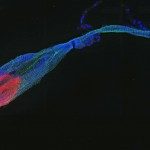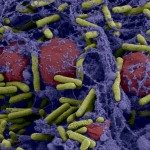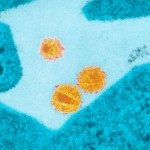Link to Pubmed [PMID] – 18648536
PLoS ONE 2008;3(7):e2543
The CXCL12gamma chemokine arises by alternative splicing from Cxcl12, an essential gene during development. This protein binds CXCR4 and displays an exceptional degree of conservation (99%) in mammals. CXCL12gamma is formed by a protein core shared by all CXCL12 isoforms, extended by a highly cationic carboxy-terminal (C-ter) domain that encompass four overlapped BBXB heparan sulfate (HS)-binding motifs. We hypothesize that this unusual domain could critically determine the biological properties of CXCL12gamma through its interaction to, and regulation by extracellular glycosaminoglycans (GAG) and HS in particular. By both RT-PCR and immunohistochemistry, we mapped the localization of CXCL12gamma both in mouse and human tissues, where it showed discrete differential expression. As an unprecedented feature among chemokines, the secreted CXCL12gamma strongly interacted with cell membrane GAG, thus remaining mostly adsorbed on the plasmatic membrane upon secretion. Affinity chromatography and surface plasmon resonance allowed us to determine for CXCL12gamma one of the higher affinity for HS (K(d) = 0.9 nM) ever reported for a protein. This property relies in the presence of four canonical HS-binding sites located at the C-ter domain but requires the collaboration of a HS-binding site located in the core of the protein. Interestingly, and despite reduced agonist potency on CXCR4, the sustained binding of CXCL12gamma to HS enabled it to promote in vivo intraperitoneal leukocyte accumulation and angiogenesis in matrigel plugs with much higher efficiency than CXCL12alpha. In good agreement, mutant CXCL12gamma chemokines selectively devoid of HS-binding capacity failed to promote in vivo significant cell recruitment. We conclude that CXCL12gamma features unique structural and functional properties among chemokines which rely on the presence of a distinctive C-ter domain. The unsurpassed capacity to bind to HS on the extracellular matrix would make CXCL12gamma the paradigm of haptotactic proteins, which regulate essential homeostatic functions by promoting directional migration and selective tissue homing of cells.


